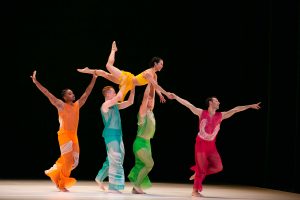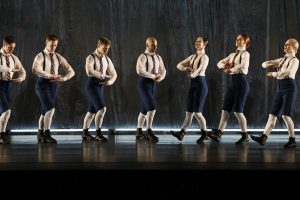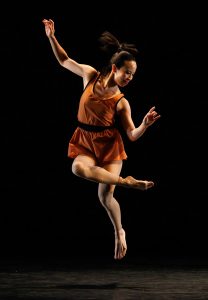
Once again, the Paul Taylor Dance Company graced the stage of the Duncan Theatre as they closed out the season for the 2024 Modern Dance Series. This world-famous modern dance company (which last performed at the Duncan pre-COVID) has been a regular participant in the Modern Dance Series for the last decade and the March 15 show marked its seventh visit.
One can view a dance company’s performance through many lenses. There is the fresh perspective of seeing a company perform for the first time, and the comparing lens one tends to use if one has seen the company perform many times. One’s view might be affected by the repertory selection or even the placement order of the dances in the program. It could also be shaped by the other companies performing on the same season’s series, but nothing is as profound as seeing a company after a change in artistic leadership — especially if that company that has been dedicated to solely presenting the works of choreographer as iconic as Paul Taylor.
When Taylor died in 2018 at age 88, he had already envisioned how his company would carry on without him as well as who would carry on his life’s work. In addition to preserving his choreography, he also wanted to provide opportunities for upcoming choreographers by having them create works for his company that would not only provide the choreographers with greater exposure but also give his dancers additional artistic challenges. And for this role, he chose Michael Novak, who had been a company dancer for nine years and performed 56 roles in 50 Taylor dances.
First up in the program on March 15 was Somewhere in The Middle, choreographed in 2022 by Amy Hall Garner, who is a hot commodity right now in the dance world, having just set a work on Alvin Ailey as well as Miami City Ballet. Garner, who is adept at choreographing in all styles of dance, wanted to blend the essence of what is considered Taylor movement with the inherent qualities of the jazz idiom thus merging two American art forms — modern dance and jazz.
Serving as a lively introduction to the company members, Somewhere in The Middle is chock full of energy and personality. Dressed in oversized, chiffon short dresses, shirts and pants in bright primary colors designed by Mark Eric, the Taylor dancers showed off their athleticism to the jazz of Count Basie, Sarah Vaughan, Duke Ellington, Wynton Marsalis and Bill Evans.
Set against a monochromatic black background and white flooring, the lighting design by Jennifer Tipton really popped the colors of the costumes and set up the mood of children’s play on a spring day. Eight dancers filled the stage with carefree smiles and joyful abandonment as they delighted in the Tayloresque movement. Devon Louis hung in the air in his jumps, Jada Pearlman was a ball of energy, Lisa Borres lit up the stage and Madelyn Ho, dressed in yellow, was eye-catching with her speed and clarity.

Next up was the powerful and expertly crafted Taylor work, The Word, which was first performed in 1998. Taylor was revered for his authentic and diverse choreographic voice which was sometimes light and sometimes dark (and even irreverent at times), but it was always unpretentious and relevant.
Taylor had said that his original inspiration for The Word originated from Byzantine art, but the work has a strong sense of religious oppression to it. The powerful and expertly crafted choreography was familiar Taylor movement but somehow it appeared amazingly fresh in this striking piece, which was well-supported by the score by David Israel, who said the score’s structure was based on the Greek Orthodox service.
Fluorescent light tubes peeked out from under a paneled gray backdrop that, when illuminated by Tipton, alternated between looking like a luxurious silk curtain to that of a solid steel wall helping to create in the palpable sense of restriction onstage.
The men and women were dressed identically in stripped ties, royal blue knickers, suspenders and wore tall white knit knee-socks and laced black boots designed by Santo Loquasto.
There was an ominous verse included in the program: “For our God is a consuming fire. — Hebrews 12:29.” With stoic expressions and slicked-back hair, the dancers mounted each other like a wall, changed line formations and cast tall shadows on the backdrop — all with defeated effort. Three men detachedly watched Austin Kelly dance his solo, which was filled with agitation.
Ho again was the central figure in this work. Dressed in a provocative transparent mesh unitard, she lurked and crept around this mass of uniformity as if she was a constant reminder of a forgotten and dark side of humanity, adding another dimension to the choreography’s message of religious conformity and oppression.
Syzygy, the last work on the program, was choreographed by Taylor in 1987 to a driving commissioned score by Donald York with whom Taylor had a longtime (almost 50 years) artistic and collaborative relationship. In the program, under the title, was the definition for syzygy — “The newly straight line configuration of three or more celestial bodies in a gravitational system.” Both the choreography and the music were born from this concept and pulsed with energetic force that almost seemed to be spinning out of control.

At times, the mood of the work was lighthearted and at other times, it was almost combative. Groupings were fast and furious as the dancers abandoned themselves to an almost messy, relaxed approach to the choreographed steps. There were quirky little human gestures that surprised during the barrage of quickly executed movement on and off the stage — was that a kiss, a wave? So was it intentional that the unison movement be so free-form, like cosmic forces that were unable to be contained?
The speed of the work continued escalating, but there were moments of respite where things calmed down, such as when Ho, with ponytail bouncing, danced a light and personable solo center stage as the other dancers paused their energy and gathered to form a seated circle around her to watch. Ho was the calming central force amid the whirling force of the choreography — akin to the sun around which all the dancers’ movement orbited. With elegance and simplicity, she began and ended the dance alone on the empty stage, slowly rotating on one leg with the other bent and lifted behind her.
The short and stiff, autumn-colored and belted tunics for the women seemed an odd choice for the celestial motif as did the men’s harem pants and black undershirt tops. Designed by Loquasto, they gave a decidedly dated look to the work. But the unflagging athleticism and energy of the dancers overshadowed this, and Syzygy served well as the final selection of the evening, leaving the audience invigorated and enthusiastic for the return of company to Palm Beach.
Artistic director Novak presented an artistic and accessible program that was just the tip of the iceberg of the company’s mission of presenting works of highly acclaimed new choreographers alongside the works of the founding artistic director. It is not easy to balance these new works on the same program as the iconic work of modern dance’s most beloved renegade, but undoubtedly it is essential to preserve and celebrate the legacy of Taylor dances for future audiences. Success is defined in many ways and in the case of the Paul Taylor Dance Company, it is that the new leadership under Novak is keeping Taylor’s artistic spirit alive and fresh, as viewed by the company’s recent performance at the Duncan Theatre.